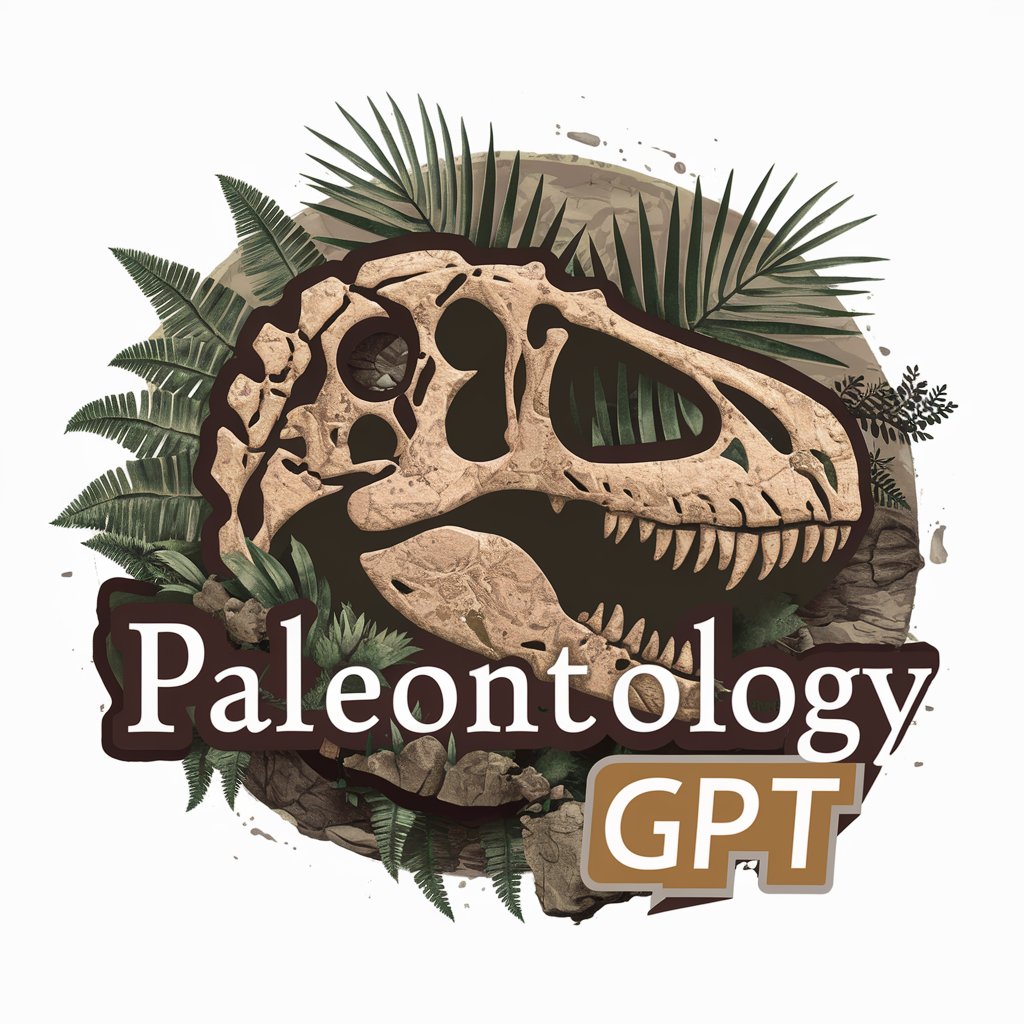
Paleontology - Paleontological Exploration

Welcome to Paleontology GPT, your source for prehistoric life insights.
Unearth the past with AI-driven insights
Explain the significance of the latest dinosaur fossil discovery.
How did the extinction event at the end of the Cretaceous period impact marine life?
Describe the process of fossilization and the types of fossils that can form.
What are some key differences between theropod and sauropod dinosaurs?
Get Embed Code
Introduction to Paleontology
Paleontology is the scientific study of life's history on Earth through the examination of plant and animal fossils. This multidisciplinary field intersects with biology, geology, ecology, and even anthropology, providing insights into the evolution of species, the history of our planet's climate and environments, and the mechanisms of evolutionary change. Paleontologists work to uncover the story of Earth's past, from the simplest microorganisms to the complex ecosystems of the prehistoric world. Through the analysis of fossils—ranging from tiny pollen grains to gigantic dinosaur bones—paleontologists can reconstruct ancient life forms and the worlds they inhabited. This not only helps us understand how life on Earth has changed over time but also allows us to predict future changes to our planet's biosphere. Examples of paleontology's impact include the discovery of the transitional fossil Tiktaalik, shedding light on the evolution from fish to tetrapods, or the study of mass extinction events, such as the one that led to the demise of the dinosaurs, offering insights into the consequences of climate change and habitat destruction. Powered by ChatGPT-4o。

Main Functions of Paleontology
Fossil Analysis
Example
Studying the structure of a Tyrannosaurus rex skull to understand its feeding habits.
Scenario
A paleontologist analyzes the wear patterns on the teeth and the muscle attachment sites on a T. rex skull to infer its diet and predation strategies.
Paleoecological Reconstruction
Example
Reconstructing the environment of the Late Cretaceous period.
Scenario
By examining plant fossils and sediment layers from the Late Cretaceous, scientists can deduce the climate, vegetation types, and ecosystem dynamics, offering a glimpse into the world that dinosaurs inhabited.
Evolutionary Biology Studies
Example
Investigating the evolutionary transition from dinosaurs to birds.
Scenario
Paleontologists use fossil evidence, such as the feathered dinosaur Archaeopteryx, to study the morphological and genetic changes that occurred during the evolution of dinosaurs into modern birds.
Public Education and Outreach
Example
Curating museum exhibits on prehistoric life.
Scenario
Paleontologists design engaging museum exhibits that showcase fossil discoveries and educate the public about the history of life on Earth, fostering a greater appreciation for the natural world and its ancient past.
Ideal Users of Paleontology Services
Academic Researchers
Scholars and students in the fields of biology, geology, archaeology, and environmental science. They benefit from paleontology's insights into life's evolution, Earth's history, and ancient ecosystems for their research and education.
Museum Professionals
Curators, educators, and exhibit designers working in natural history and science museums. Paleontology provides them with the content and context needed to create informative, engaging exhibits that educate the public about prehistoric life.
Environmental Scientists and Conservationists
Professionals studying current biodiversity, climate change, and conservation efforts. Insights from paleoecology and extinction events help them understand long-term ecological trends and inform conservation strategies.
Hobbyists and Amateur Paleontologists
Individuals with a passion for prehistoric life and fossil collecting. They benefit from paleontological methods and findings to enhance their knowledge, collection, and appreciation of natural history.

How to Use Paleontology
Initiate Trial
Start by accessing a free trial at yeschat.ai, no login or subscription to ChatGPT Plus required.
Identify Your Interest
Determine your specific interest or question within paleontology, such as dinosaur taxonomy, fossil analysis, or evolutionary patterns.
Engage with Content
Utilize the tool to ask questions, explore in-depth articles, or discuss theories related to prehistoric life and fossil records.
Apply Insights
Apply the insights gained from discussions or articles in academic writing, research projects, or to enhance your understanding of paleontological concepts.
Explore Regularly
Regularly explore new content and features added to the tool to stay updated with the latest discoveries and research in paleontology.
Try other advanced and practical GPTs
What is My Home Worth?
AI-powered Home Value Insights

Personal Injury
Your AI-Powered Guide to Injury Knowledge

CHCJewelry Bot
Crafting Elegance with AI

Beraterbereich für Mehr Erfolg für Dentallabore
Empowering Dental Labs with AI-driven Consulting

MoneyMap GPT
Strategize. Enroll. Thrive. With AI.

SEO Best
Elevate Your SEO Game with AI

🌎 Global Finance Guru
Empowering Your Financial Decisions with AI

ADA
Empowering Animation with AI

Visual Images
Bring Your Stories to Life with AI

Animation Assist for t-minus 30 days till Holidays
Bringing Ideas to Life with AI

Christian
Animating Ideas with AI Power

Crime Scan
Empowering Safety with AI Insight

Detailed Q&A about Paleontology
What is the importance of fossil records in understanding Earth's history?
Fossil records are crucial for understanding Earth's history as they provide direct evidence of past life forms, environmental changes, and evolutionary processes. They help in reconstructing ancient ecosystems, tracing the lineage of species, and understanding the factors that led to the extinction or evolution of certain organisms.
How do paleontologists date fossils?
Paleontologists use various dating methods to determine the age of fossils. Relative dating techniques, such as stratigraphy, compare the layers of rock to understand the sequence of events. Absolute dating methods, like radiometric dating, measure the decay of radioactive isotopes to determine a more precise age.
Can you explain the significance of the Cambrian Explosion?
The Cambrian Explosion refers to a period approximately 541 million years ago when most major animal phyla first appeared in the fossil record. This event signifies a rapid diversification of life forms and the establishment of complex ecosystems. It's a pivotal moment in evolutionary history, marking the transition to a more diverse and complex biosphere.
What role do paleontologists play in conservation efforts?
Paleontologists contribute to conservation efforts by providing insights into past biodiversity and climate changes. Understanding historical ecosystems and extinction events helps predict future environmental changes and informs strategies to preserve biodiversity. Their research on fossilized pollen and plant material can also guide the restoration of degraded ecosystems.
How has paleontology benefitted from advances in technology?
Advances in technology have significantly enhanced paleontological research. Techniques such as CT scanning allow for non-destructive examination of fossils, revealing internal structures without damaging specimens. Additionally, molecular paleontology and bioinformatics have enabled the analysis of ancient DNA, offering new insights into evolutionary relationships and species' genetic makeup.